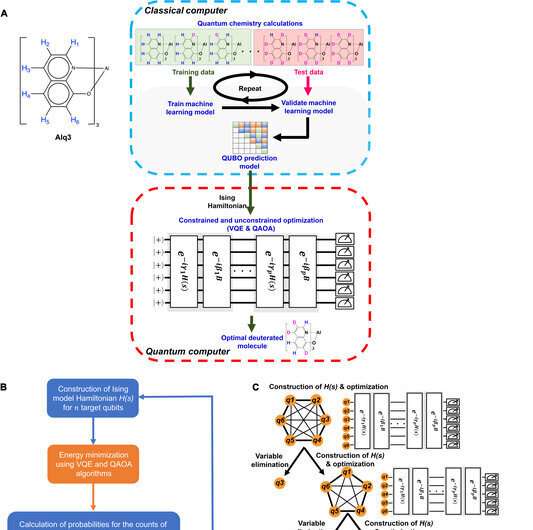This article has been reviewed according to Science X's editorial process and policies. Editors have highlighted the following attributes while ensuring the content's credibility:
fact-checked
proofread
Better and faster design of organic light-emitting materials with machine learning and quantum computing

Over the past decade, organic luminescent materials have been recognized by academia and industry alike as promising components for light, flexible and versatile optoelectronic devices such as OLED displays. However, it is a challenge to find suitably efficient materials.
To address this challenge, a joint research team has developed a novel approach combining a machine learning model with quantum-classical computational molecular design to accelerate the discovery of efficient OLED emitters. This research was published May 17 in Intelligent Computing.
The optimal OLED emitter discovered by the authors using this "hybrid quantum-classical procedure" is a deuterated derivative of Alq3 and is both extremely efficient at emitting light and synthesizable.
Deuterated OLED emitters are organic materials in which hydrogen atoms are replaced with deuterium atoms in the emitter molecules. Although they have the potential to emit light very efficiently, designing such deuterated OLED emitters poses a computational challenge. This challenge arises from the need to optimize the position of deuterium atoms in the emitter molecules, which requires calculations to be performed from scratch.
The new workflow, which involves both a classical computer and a quantum computer, speeds up these calculations. First, quantum chemistry calculations are performed on a classical computer to obtain the "quantum efficiencies" of a set of deuterated Alq3 molecules. These data about the light-emitting efficiency of different molecules are used to create training and test datasets for building a machine learning model to predict the quantum efficiencies of various deuterated Alq3 molecules.
Next, the machine learning model is used to construct an energy function of the system, known as a Hamiltonian. Quantum optimization is then performed on a quantum computer using two quantum variational optimization algorithms—the variational quantum eigensolver (VQE) and the quantum approximate optimization algorithm (QAQA)—to aid machine learning to discover molecules with optimal quantum efficiencies. A synthetic constraint is introduced during the quantum optimization process to ensure that the optimized molecule is synthesizable.
To improve the accuracy of the prediction on quantum devices, the authors adopted a noise-robust technique called recursive probabilistic variable elimination (RPVE), and managed to "find the optimal deuterated molecule with very high accuracy using a quantum device." In addition, they point out that combining this new noise-robust technique with their two chosen quantum optimization algorithms could achieve quantum advantage for the calculations on near-term quantum devices.
Generally, the authors expect that their approach, which combines quantum chemistry, machine learning and quantum optimization, could create "new opportunities to generate and optimize key molecules for material informatics."
More information: Qi Gao et al, Quantum-Classical Computational Molecular Design of Deuterated High-Efficiency OLED Emitters, Intelligent Computing (2023). DOI: 10.34133/icomputing.0037
Provided by Intelligent Computing





















